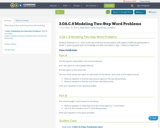
This task provides students practice with modeling.
- Subject:
- Education
- Elementary Education
- Mathematics
- Numbers and Operations
- Material Type:
- Activity/Lab
- Assessment
- Homework/Assignment
- Date Added:
- 08/16/2018

This task provides students practice with modeling.
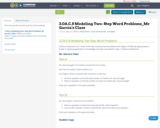
This task provides students practice with modeling.

Students review the standard long-division algorithm and discuss the different ways the answer to a whole-number division problem can be expressed (as a whole number plus a remainder, as a mixed number, or as a decimal).Students solve a series of real-world problems that require the same whole number division operation, but have different answers because of how the remainder is interpreted.Key ConceptsStudents have been dividing multidigit whole numbers since Grade 4. By the end of Grade 6, they are expected to be fluent with the standard long-division algorithm. In this lesson, this algorithm is reviewed along with the various ways of expressing the answer to a long division problem. Students will have more opportunities to practice the algorithm in the Exercises.Goals and Learning ObjectivesReview and practice the standard long-division algorithm.Answer a real-world word problem that involves division in a way that makes sense in the context of the problem.
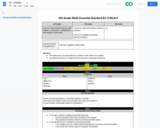
The placement of a decimal has an effect on the value of a number.
Use decimal fluency to analyze errors and solve real-world situations.
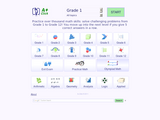
A+ Click is an interactive collection of more than 3700 math problems and answers for K-1 K-12 school program. It defines the personal level of math knowledge. You move up into the next level if you give 5 correct answers in a row. Practice makes perfect.

This is an interactive assessment and video designed to teach Adding and Subtracting (Numbers up to 20) - Word Problems to first graders.

National Board Certified teacher Marlo Warburton introduces a fresh approach to teaching the notoriously difficult "mixture" word problems for Algebra I. Using an in-class demonstration and incorporating basic physics principles of weight and distance, Ms. Warburton helps her students visualize, solve -- and even enjoy! -- these challenging problems.
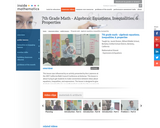
This lesson is about trying to get students to make connections between ideas about equations, inequalities, and expressions. The lesson is designed to give students opportunities to use mathematical vocabulary for a purpose to describe, discuss, and work with these symbol strings.The idea is for students to start gathering global information by looking at the whole number string rather than thinking only about individual procedures or steps. Hopefully students will begin to see the symbol strings as mathematical objects with their own unique set of attributes. (7th Grade Math)
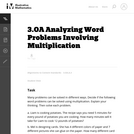
In this task, the students are not asked to find an answer, but are asked to analyze word problems and explain their thinking. In the process, they are faced with varying ways of thinking about multiplication.
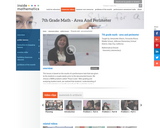
This lesson is based on the results of a performance task in which we realized that students' understanding of area and perimeter was mostly procedural. Therefore the purpose of this re-engagement lesson was to address student misconceptions and deepen student understanding of area and perimeter. The standards addressed in this lesson involve finding perimeter and area of various shapes, finding the perimeter when given a fixed area, and using a formula in a practical context. Challenges for our students included decoding the language in the problem and proving their thinking. (7th Grade Math)
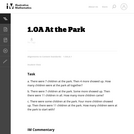
These 3 word problems require students to solve addition and subtraction problems.

This series of word problems requires students to apply the concepts of factors and common factors in a context.
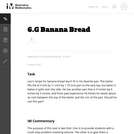
The purpose of this task is to provide students with a multi-step problem involving volume and to give them a chance to discuss the difference between exact calculations and their meaning in a context.

Try this fun problem! In any group of six people, what is the probability that everyone was born in different months?
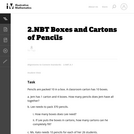
This instructional task requires students to figure out word problems that require thinking in base 10.
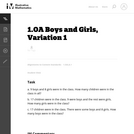
Students use addition or subtraction to solve these types of word problems.
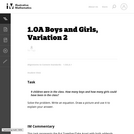
This word problem has 10 possible solutions.

MATH&148 is a calculus course for business students. It is designed for students who want a brief course in calculus. Topics include differential and integral calculus of elementary functions. Problems emphasize business and social science applications. Translating words into mathematics and solving word problems are emphasized over algebra. Applications are mainly business oriented (e.g. cost, revenue, and profit). Mathematical theory and complex algebraic manipulations are not mainstays of this course, which is designed to be less rigorous than the calculus sequence for scientists and engineers. Topics are presented according to the rule of four: geometrically, numerically, analytically, and verbally. That is, symbolic manipulation must be balanced with graphical interpretation, numerical examples, and writing. Trigonometry is not part of the course.

This task provides a good entry point for students into representing quantities in contexts with variables and expressions and building equations that reflect the relationships presented in the context.

There are two aspects to fluency with division of multi-digit numbers: knowing when it should be applied, and knowing how to compute it. While this task is very straightforward, it represents the kind of problem that sixth graders should be able to recognize and solve relatively quickly.